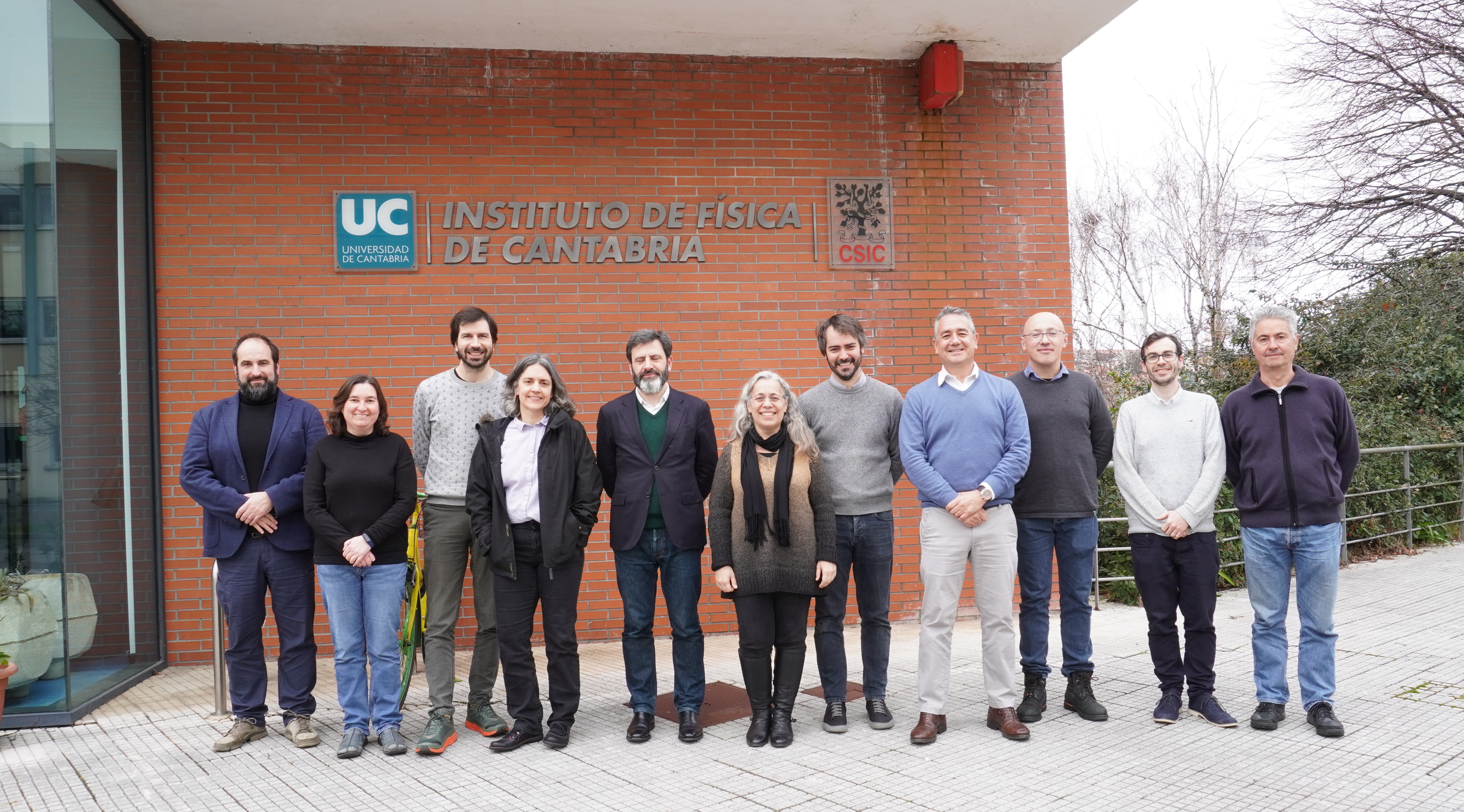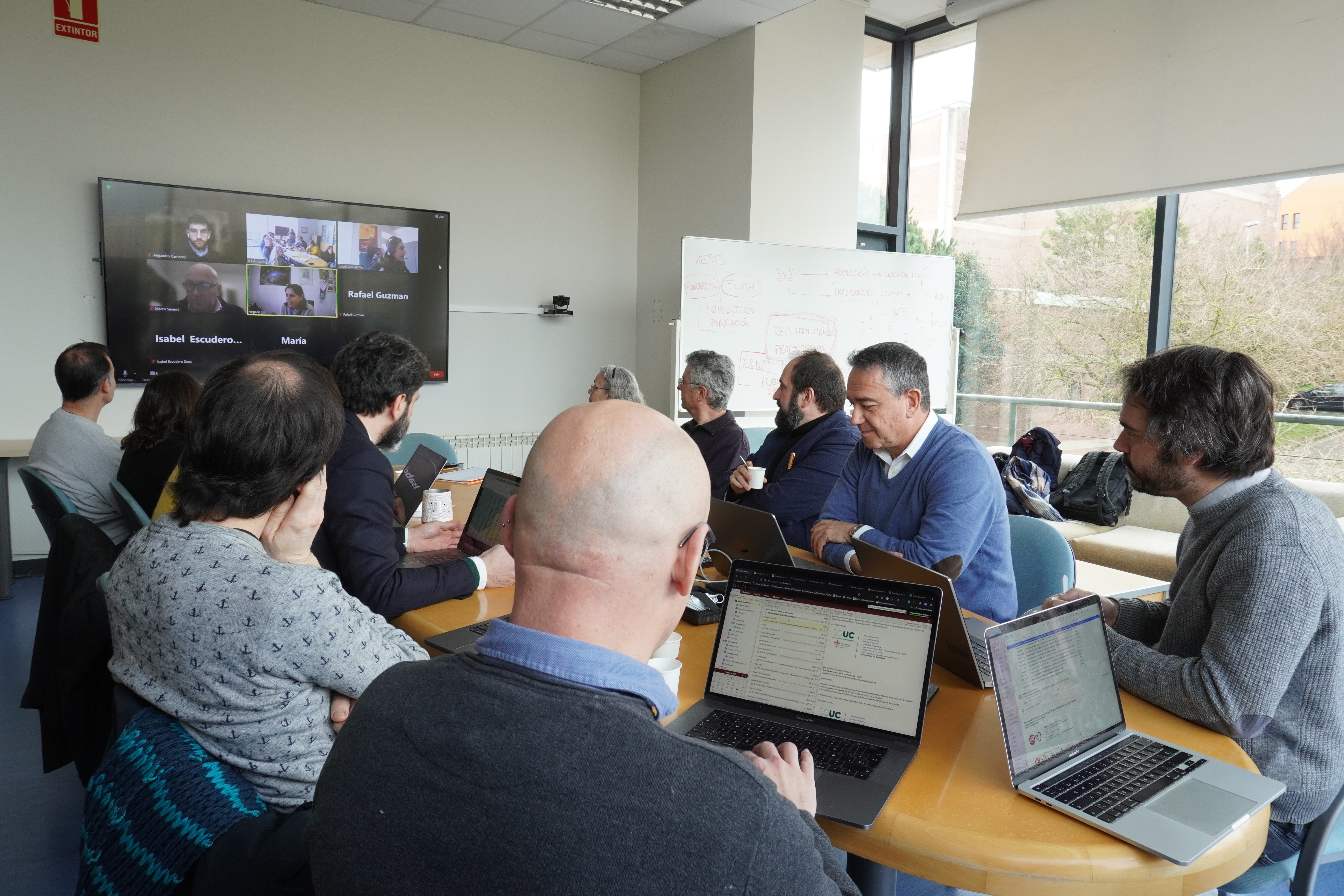
Family photo of part of the ARRAKIHS team at the end of the day.
The meeting is a first contact between the members of the ARRAKIHS space mission, which will search for dark matter in the universe
2 February 2023
Representatives of the European Space Agency (ESA), the Complutense University of Madrid (UCM) and the Basque company Satlantis visited the Institute of Physics of Cantabria (IFCA, CSIC-UC) today to get to know what will be the coordinating research centre for the ARRAKIHS space mission, which is expected to be launched in 2030.
The principal investigator of the mission, Rafael Guzmán, CSIC researcher, member of the Observational Cosmology and Instrumentation Group at IFCA and professor at the University of Florida, received the ESA team in charge of supervising the development of the ARRAKIHS mission in different aspects: Jacques Rouquet (project manager), Kate Isaak (scientific director) and Thibaut Prod'homme (payload manager). Santiago Serrano (IEEC), ARRAKIHS Instrumentation Coordinator and Chief Project Engineer at Satlanltis, and Mariangeles Gómez-Flechoso, coordinator of the Spanish ARRAKIHS node and professor at the Complutense University of Madrid (UCM), also participated in person.
The ARRAKIHS team is completed by a research group from the Instituto de Astrofísica de Andalucía (IAA-CSIC), the Instituto de Ciencias del Espacio (ICE-CSIC), the Centro de Astrobiología (CAB, INTA-CSIC) and the Centro de Estudios de Física del Cosmos de Aragón (CEFCA).
After the welcome by the director of IFCA, José Manuel Gutiérrez, the ARRAKIHS team met with the administration and services staff, the outreach and communication department, the vice-presidency of the centre and the IFCA research team involved in ARRAKIHS. At the meeting, they learned about the participation of the joint centre in previous missions, the research being carried out in dark matter, the experience in data science, and the responsibilities that IFCA will have in this ESA space mission.
The meeting served to review preliminary aspects of the preparation of the next key step for the mission, which will be to pass the Critical Design Review, due to start in mid-February, and which will be an important step in the development of ARRAKIHS.

All members of the ARRAKIHS mission, in person and remotely, discussing the next steps of the project.
An ESA mission in Cantabria
The European Space Agency's Science Programme Committee recently selected the ARRAKIHS mission as the first ESA Science Programme mission led from Spain, coordinated from IFCA, with the participation of the Instituto de Astrofísica de Andalucía (IAA-CSIC), the Instituto de Ciencias del Espacio (ICE-CSIC), the Centro de Astrobiología (CAB, INTA-CSIC), the Centro de Estudios de Física del Cosmos de Aragón (CEFCA) and the Universidad Complutense de Madrid, and with the aim to be launched in 2030.
ARRAKIHS, an acronym for "Analysis of Resolved Remnants of Accreted galaxies as a Key Instrument for Halo Surveys", was submitted to ESA's Fast Missions Opportunities programme in February last year, and an international consortium of research centres from Spain, Switzerland, the United Kingdom, Belgium, Sweden, Austria and the United States is participating in its development.
The aim of the mission is to study dark matter in the Universe, which, according to different cosmological observables, could be up to five times more abundant than ordinary matter. Because of its properties, the detection of dark matter is very complex and, for now, researchers are only aware of its existence through its gravitational effects. It is precisely these effects on satellites orbiting in the halo of galaxies, such as our Milky Way, that ARRAKIHS will be able to discover and characterise, in order to reveal the nature of dark matter.
A binocular camera
In order to observe this dark matter, the Basque company Satlantis has designed and developed a binocular visible and infrared camera that will make it possible to obtain images of one hundred galaxies similar to the Milky Way, reaching a surface brightness 5 to 100 times deeper than the best images taken from ground-based observatories. The depth, resolution and large field of the images provided by ARRAKIHS will be an astronomical milestone and will provide key information about the knowledge of dark matter in the universe and its origin.
Rebeca García / IFCA Communication
